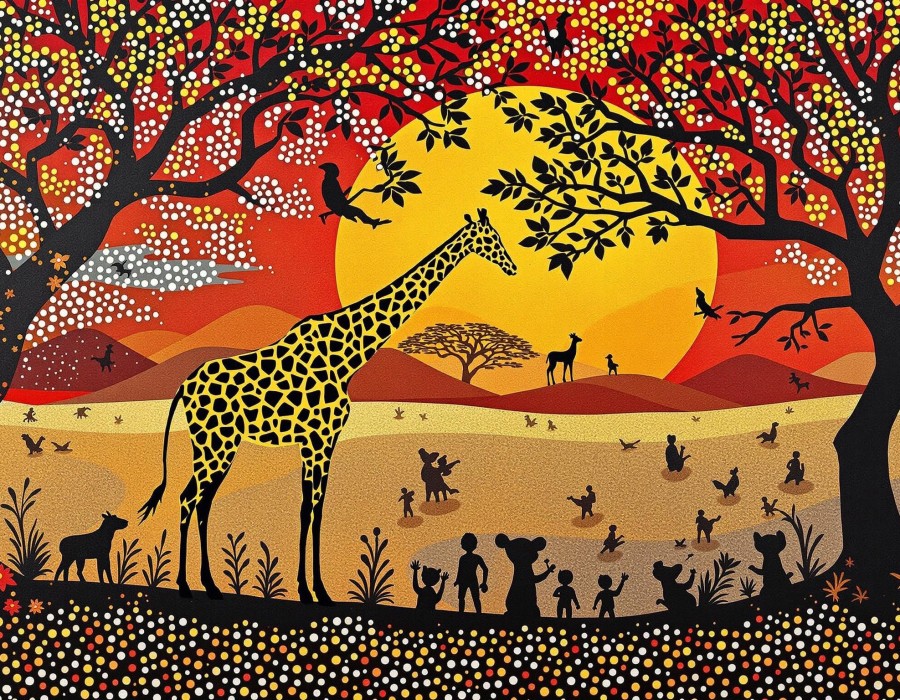The Vibrant Language of Joy
In our modern world where stress and anxiety dominate daily life, Tanzania's radiant TingaTinga paintings emerge as unexpected teachers of joy. More than just decorative art, these colorful works—bursting with playful animals and hypnotic patterns—offer a philosophy of happiness encoded in visual form. From Dar es Salaam’s bustling markets to international galleries, this artistic movement continues to spread its message of optimism, resilience, and communal delight through every whimsical brushstroke.
The Origins of Joyful Expression
The story begins in 1960s Tanzania, when self-taught artist Edward Saidi Tingatinga began painting his now-iconic animal scenes on square boards using bicycle enamel. His creations weren’t mere decorations—they were visual celebrations of post-colonial optimism during Tanzania’s nation-building era. At a time when the country was forging a new identity, TingaTinga art became a powerful expression of cultural pride and collective joy.
The Psychology of Color and Happiness
What makes these works so fundamentally uplifting? The answer lies in their fearless embrace of color. TingaTiga paintings don’t just use color—they celebrate it with almost reckless abandon. Electric blues, sunshine yellows, and fiery oranges don’t merely depict animals; they create an emotional experience that bypasses intellectual interpretation and speaks directly to the viewer’s spirit. Modern color psychology confirms what these Tanzanian artists understood instinctively: certain hues can elevate mood, trigger dopamine release, and even reduce stress.
Playful Perspectives: Seeing the World Differently
Beyond their chromatic brilliance, TingaTinga paintings teach us about perspective. The artists take familiar African wildlife—lions, elephants, giraffes—and reimagine them through a lens of joyful distortion. A zebra might sport polka dots instead of stripes; a crocodile might grin rather than snarl. This whimsical approach reminds us that happiness often depends on our willingness to reframe the ordinary, finding delight in unexpected places.
The Cultural Dimensions of Happiness
Joy as a Communal Experience
Unlike Western individualism, TingaTinga art embodies an African philosophy of happiness rooted in community. Traditionally, these paintings were created in collaborative workshops where artists shared techniques and inspiration. This collective spirit infuses the artworks with a sense of shared delight—a reminder that joy multiplies when experienced together.
Democratizing Delight: Art for Everyone
The movement also champions accessibility. Unlike elite art forms requiring expensive materials or formal training, TingaTinga began with humble supplies and techniques anyone could learn. This democratic approach suggests a key happiness principle: joy flourishes when barriers to creative expression are removed.
The Modern Relevance of TingaTinga Joy
Neuroscience Meets Folk Art
Remarkably, modern science validates the happiness principles embedded in these artworks:
- Circular compositions activate the brain’s pleasure centers
- Repetitive patterns induce meditative calm
- Bold colors and imaginative scenes stimulate creative thinking—a mental state linked to wellbeing
Imperfection as Liberation
In a world obsessed with filters and flawless aesthetics, TingaTinga art celebrates the beauty of the imperfect. The slightly uneven lines, asymmetrical designs, and "flaws" give each piece its character—testament to the joy of authentic expression over sterile perfection.
Bringing TingaTinga Wisdom into Daily Life
We don’t need to own a painting to benefit from its lessons. Here’s how to channel its spirit:
- Reframe challenges – Imagine problems as one of those smiling TingaTinga animals; suddenly, they seem lighter.
- Seek uplifting colors – Incorporate vibrant hues into your surroundings for an instant mood boost.
- Embrace "happy accidents" – Like the artists, find beauty in unplanned moments.
Conclusion: The Enduring Power of Joyful Art
In museums and markets worldwide, TingaTinga paintings continue spreading their infectious joy. They stand as testament to a profound truth: happiness persists, even in unlikely circumstances. The animals may laugh in color, but their message is deeply human—that creativity heals, that community sustains us, and that sometimes, the wisest lessons come dressed in leopard spots and sunshine.
"The world is already fierce—why not paint it joyful?"





Comments